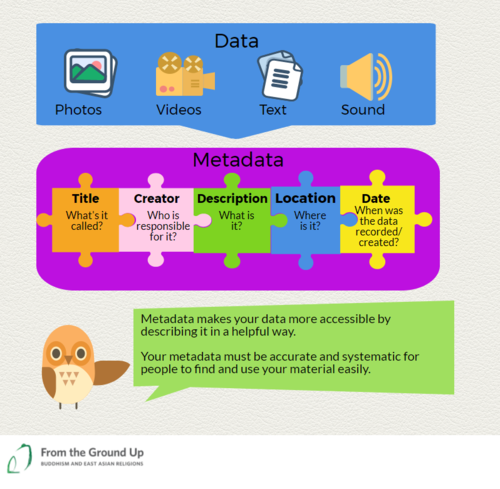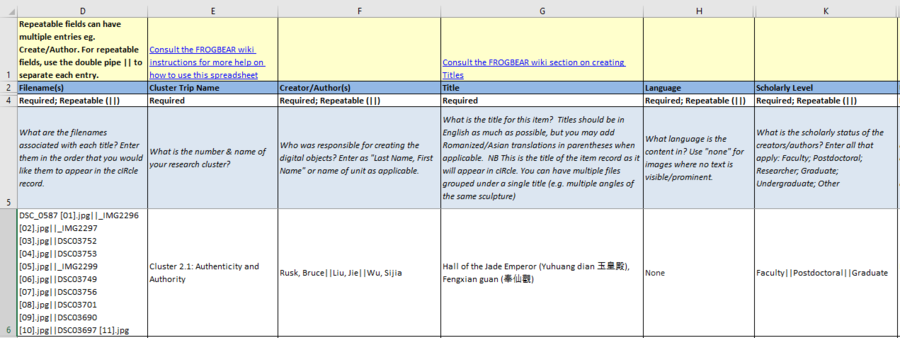Documentation:Library:Circle/FROGBEAR Describing your data
Overview
This document explains how to describe your data when filling out the metadata spreadsheet. Every item in the collection must be accompanied by metadata so that users can find it and understand it.
Basic Metadata Concepts
Item: The entire object or group of objects you are capturing
Data: Images/videos related to a single item or site
Metadata: Description of everything the data represents
Record: The combination of data and metadata that creates meaning

Metadata Spreadsheet
The repository uses metadata standards and best practices to make content discoverable and useable by anyone, anywhere. For this reason, every research cluster team creating objects destined for the repository must use the cIRcle Metadata Template. You can download a copy of the spreadsheet template here' File:Frogbear cIRcle MetadataTemplate 2021.xlsx
Every row in the spreadsheet represents a record, which will appear as a single unit in the online repository. It may contain multiple items (files) such as a set of images of the same object or site, multiple segments of video, or an audio recording and a text transcript of the recording.
See, for example, the following entry in the metadata template:
For items to be grouped together in a record, they must all be related enough to be described by a single title and set of keywords.
Look at how the above example is displayed in Open Collections to see how the metadata in the spreadsheet is translated for the person viewing the metadata online: "Hall of the Jade Emperor (Yuhuang dian 玉皇殿), Fengxian guan (奉仙觀)". View the same record displayed in the FROGBEAR database https://frogbear.org/app/#/record/1.0348721
Note that there are 11 images associated with this one item record. The "Description" field provides context for each photograph in the item record so that anyone viewing this record can understand how they are all connected and what each image file contains.
To better understand how each field should be used, review the description below of each metadata field for tips on how to describe items in the Frogbear metadata template.
|
Tip Choose one research cluster team member to be responsible for making sure that the metadata provided in the template is consistent and accurate. This person should also be the contact for repository staff to answer questions and provide clarification as needed.</ref> |
Types of Fields
Required Fields
Some fields are required, meaning that you must enter some information into those categories in order for your items to appear in the repository. Optional fields may be left blank. If a required field is missing metadata, we will contact the cluster leader or a designate for more information.
Repeatable Fields
Some fields are marked “Repeatable (||)”. This means that you can enter multiple terms. Each term should be separated by double vertical line characters (||, the vertical line is entered with shift-backslash on most keyboards).
An example of a Repeatable field is Creator; this ensures that everyone who created items in the record is listed. In the example above, the creator names were entered in the spreadsheet as: Rusk, Bruce || Liue, Jie ||Wu, Sijia. These fields are linkable in Open Collections so you can click on a creators name and see all of the records associated with that person. For this reason, names need to be entered consistently.
Use of Fields
Filename Field
This field links the metadata in the spreadsheet to the material in the data files is the Filename(s) field. Before you start creating files, it is important to have a plan for how your research cluster will organize and name it's files. For recommendations on managing your files, see this guide: Documentation:Library:Circle/FROGBEAR Organizing content for upload
Title Field
The title field is important as it gives the record a name and helps people to find your items. In most cases, you will be responsible for creating your own titles so you will need to use it to describe what the image or video is, or what is seen in the item record. Before you start creating titles, see our guide for tips and examples on creating title metadata: Documentation:Library:Circle/FROGBEAR Title metadata
Description Field
The description field gives a brief explanation of content. It is typical a few sentences long and gives detail about the content and context of the text, photo, video, or audio file. If you have multiple files for one record, this is also where you would describe what is seen in each file. For more information on how to create descriptions, see Documentation:Library:Circle/FROGBEAR Description metadata
Geographic Field
Use this field when the content is about a specific location (e.g. Jiyuan Shi (China)). Include place name (province, village, etc.) where the image or video was created. View a FROGBEAR record in cIRcle for examples: http://hdl.handle.net/2429/62158
Latitude/Longitude Field
Latitude and longitude are captured in decimal form in separate fields in the spreadsheet to ensure they are entered correctly. Review these tips on identifying and collecting latitude and longitude using Google Maps. You may also want to explore other free geographic tools such as this degree to decimal converter. You can also use an Excel formula to convert from degrees to decimal.
